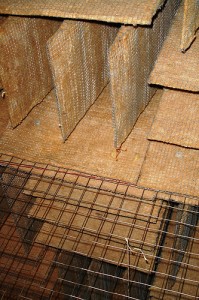Today’s activities centered around sound. Tyler Adam’s “Sound and Science” lecture included brief history about technological advances related to sound. For example, the theremin is an instrument  developed in 1919 which operates using the heterodyne principle. and involves the interaction of two radio frequency oscillators to produce sound. Sound technology seems to define our generations, such as 80’s robotic style and today’s use of auto-tune.
developed in 1919 which operates using the heterodyne principle. and involves the interaction of two radio frequency oscillators to produce sound. Sound technology seems to define our generations, such as 80’s robotic style and today’s use of auto-tune.
We went in small groups in UCLA’s anechoic chamber. It is designed to absorb sound and block out radio waves.

anechoic chamber
As we sat in silence on the suspended mesh flooring in pitch black (completely pitch-closing and opening your eyes in there made no difference), it was a very unique, strange experience. You feel closed in and as if the room extends indefinitely at the same time; trapped and free. Anechoic means “without echo” but it the sound in my ears felt like my body’s echoes. We each had a roll of scotch tape because, once our eyes adjust to the total darkness, we are able to see the bit of visible light emitted by the end of the tape when peeled.
I didn’t go to the Harry Potter and the Half Blood Prince movie last night (er, this morning), but I have read the series so I can talk about Harry Potter in relation to technology. The first thing I thought of was an article I read a few months ago about the development of a real invisibility cloak.This “invisibility cloak” is made of nanostructured silicon. It could perhaps change military strategy. Pensieves in the Harry Potter world store memories and allow us to look at them later. One thing that this made me think of in our world was a man that I read about who replaced his one prosthetic eye for one that is actually a video camera, recording his life. There is also a brain implant being engineered to recreate thoughts, which is a similar function to a pensieve.

a pensieve
Pictures in the wizarding world show their subjects in motion. TV screens have been developed that are thin as paper, so there is potential for them to be put to use in magazines, but I doubt newspapers because the technology is probably too expensive and newspapers are becoming obsolete anyway. In addition to the science behind turning fantastical book ideas into real-life things, there is a lot of science behind the making of the Harry Potter movies. The imaginary creatures such as dementors and inferi are created by studying anatomy and 3D models, and how materials move and change in different environments. There is also of course a lot of computer generated imagery that involves study of movement and shape which we have been talking about, as well as the artistic aspect.